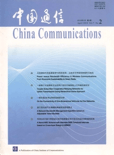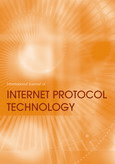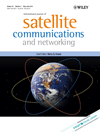
China Communications
Scope & Guideline
Connecting Scholars to the Future of Information Technology
Introduction
Aims and Scopes
- Wireless Communication Technologies:
Research on various wireless communication technologies including mobile networks, satellite communications, and IoT, emphasizing novel approaches like NOMA, MIMO, and RIS to improve efficiency and security. - Intelligent Systems and AI Integration:
Exploration of artificial intelligence and machine learning techniques in communication systems, such as deep learning for signal detection, resource allocation, and optimization in various network scenarios. - Security and Privacy:
Focus on physical layer security, privacy-preserving protocols, and blockchain applications in communication networks, addressing vulnerabilities and enhancing data integrity. - Network Management and Optimization:
Studies on network resource allocation, traffic engineering, and optimization strategies in heterogeneous networks, including edge computing and mobile edge networks. - Emerging Technologies and Standards:
Investigation into the development and implementation of next-generation communication standards such as 6G, focusing on aspects like terahertz communications, integrated sensing, and cognitive radio.
Trending and Emerging
- Cognitive and Intelligent Communications:
There is a growing emphasis on cognitive communication systems that adapt to their environment, utilizing AI and machine learning to optimize performance and resource usage. - Secure and Reliable Communications:
Emerging research focuses on enhancing security through advanced techniques such as physical layer security, blockchain integration, and privacy-preserving methods in communication networks. - Integration of Sensing and Communication:
The convergence of sensing and communication technologies, particularly in the context of IoT and smart environments, is a trending area of research, emphasizing integrated systems for improved functionality. - Edge Computing and Mobile Edge Networks:
The rise of edge computing technologies is evident, with increasing studies on optimizing resource allocation and task offloading in mobile edge computing scenarios. - Terahertz and Next-Generation Technologies:
There is a significant interest in exploring terahertz communications and other next-generation technologies as foundational elements for 6G and beyond, reflecting the journal's forward-looking perspective.
Declining or Waning
- Traditional Communication Models:
Research on classical communication models, such as single-input single-output (SISO) systems, has diminished as the field shifts towards more complex and integrated systems like MIMO and NOMA. - Basic Signal Processing Techniques:
Studies centered on fundamental signal processing techniques are becoming less frequent, as the focus transitions towards advanced algorithms leveraging AI and machine learning. - Legacy Security Protocols:
Interest in older security protocols is waning, with more emphasis now placed on innovative, adaptive security measures utilizing blockchain and AI-driven strategies. - Static Network Management Approaches:
Static and manual network management techniques are being overshadowed by dynamic, AI-driven approaches that offer greater adaptability to changing network conditions. - Conventional Routing Algorithms:
The prevalence of traditional routing algorithms has decreased as researchers explore more sophisticated, adaptive methods that leverage real-time data and AI for improved performance.
Similar Journals

IEEE COMMUNICATIONS MAGAZINE
Unveiling Trends in Computer Networks and ApplicationsIEEE Communications Magazine, published by the Institute of Electrical and Electronics Engineers (IEEE), is a leading journal in the fields of Computer Networks and Communications, Computer Science Applications, and Electrical and Electronic Engineering. With an impressive impact factor reflected in its Q1 quartile rankings across multiple categories, this periodical stands at the forefront of technological advancement and innovation. Since its inception in 1979, the magazine has been committed to disseminating high-quality research and insightful reviews that address current issues in communications technology. Targeting an audience that includes researchers, industry professionals, and students, IEEE Communications Magazine strives to foster a deeper understanding of emerging trends and challenges in the communications sector. Its affiliation with IEEE, a global leader in advancing technology, underlines the journal's credibility and significance in supporting scholarly communication in electrical and electronic engineering. The magazine operates without open access options, necessitating subscription or institutional access for its comprehensive content.

Electronics
Unveiling Insights in Electronics and CommunicationElectronics, published by MDPI since 2012, stands as a pivotal open-access journal that caters to a wide spectrum of disciplines within the electrical and electronic engineering domain. With a strong commitment to disseminating innovative research, this journal has garnered notable recognition, achieving a Q2 ranking in multiple pertinent categories, including Computer Networks and Communications, Control and Systems Engineering, and Signal Processing. Its editorial standards and open-access format enhance the visibility and accessibility of high-quality research, making critical advancements in technology available to a global audience. Located in Switzerland, the journal is positioned to foster international collaboration and dialogue among researchers, professionals, and students dedicated to exploring the evolving landscape of electronics and its applications. With an E-ISSN of 2079-9292, the journal is meticulously indexed in reputable databases like Scopus, further solidifying its relevance and influence in the engineering community.

International Journal of Internet Protocol Technology
Pioneering Research in Internet TechnologiesThe International Journal of Internet Protocol Technology (ISSN: 1743-8209; E-ISSN: 1743-8217), published by InderScience Enterprises Ltd, is an esteemed periodical dedicated to advancing research in the realms of internet protocols and communication technologies. Established in 2005 and headquartered in the United Kingdom, this journal serves as a vital platform for scholars and professionals, providing insights into innovative approaches and emerging trends within the field. With a 2023 Scopus ranking placing it in the Q4 category for Computer Networks and Communications, it continues to contribute to an evolving digital ecosystem. Although the journal does not offer open access, its articles are accessible through institutional subscriptions and provide a wealth of knowledge that aids the understanding and development of internet protocols. Researchers, practitioners, and students will find a range of high-quality studies that explore critical issues and technological advancements shaping global digital communications.

TELECOMMUNICATION SYSTEMS
Advancing the Frontier of Telecommunications ResearchTelecommunication Systems is a premier academic journal published by Springer, dedicated to advancing the field of telecommunications and information systems. With an ISSN of 1018-4864 and an E-ISSN of 1572-9451, this journal has established itself as a crucial resource in the realms of Electrical and Electronic Engineering, evidenced by its esteemed ranking in the Q2 category and a 70th percentile standing in Scopus ranks. Since its inception in 1993, it has provided an important platform for original research, innovative solutions, and theoretical developments in telecommunications technologies. The journal's objectives include fostering interdisciplinary collaboration and exploring the latest advancements in communication systems, making it essential reading for researchers, professionals, and students alike. With its commitment to quality and relevance, Telecommunication Systems remains at the forefront of scholarly communication in the dynamic telecommunications sector.

GetMobile-Mobile Computing & Communications Review
Connecting Ideas, Transforming CommunicationGetMobile-Mobile Computing & Communications Review, published by the Association for Computing Machinery (ACM), is a leading journal dedicated to the evolving field of mobile computing and communication technologies. With an ISSN of 2375-0529 and an E-ISSN of 2375-0537, this publication serves as a vital resource for researchers, professionals, and students, providing insights into the latest advancements, trends, and challenges in mobile technology. The journal covers a comprehensive range of topics, including but not limited to mobile networks, communications protocols, mobile applications, and edge computing, making it invaluable for those in academia and industry alike. Although specific metrics such as impact factor and H-index are currently unavailable, GetMobile is recognized for fostering innovative research and promoting knowledge exchange in mobile and computational communications. As the field continues to grow, this journal remains pivotal for disseminating impactful studies and practical applications that drive the future of mobile technology.

INTERNATIONAL JOURNAL OF SATELLITE COMMUNICATIONS AND NETWORKING
Unlocking the Potential of Satellite InnovationsInternational Journal of Satellite Communications and Networking is a premier academic journal published by Wiley, dedicated to advancing knowledge in the fields of satellite communications and networking. With an ISSN of 1542-0973 and E-ISSN 1542-0981, this journal has been a significant contributor to the discourse surrounding electronic and media technologies since its inception in 2003. Recognized for its rigorous peer-review process, it has achieved notable rankings, placing in the Q2 and Q3 quartiles across various categories, highlighting its impact and relevance in the competitive domains of Engineering and Media Technology. Researchers, professionals, and students can benefit from access to cutting-edge research and innovations in satellite communications, as it ranks #18/63 in Engineering Media Technology and #323/797 in Electrical and Electronic Engineering. The journal's commitment to fostering a deeper understanding of networking technology makes it an essential resource for anyone looking to stay at the forefront of this rapidly evolving industry.

ICT Express
Connecting Ideas, Transforming TechnologiesICT Express is a leading open-access journal published by Elsevier that has established itself at the forefront of the fields of Artificial Intelligence, Computer Networks and Communications, Hardware and Architecture, Information Systems, and Software. Since its inception in 2015, this South Korea-based journal has provided a vital platform for disseminating innovative research and practical applications across these rapidly evolving domains. With an impressive impact factor and consistently high Scopus rankings—placing it in the top quartiles of its categories—it attracts contributions from both seasoned experts and emerging scholars. Current access options ensure that groundbreaking findings are readily available to a global audience, thus fostering collaboration and advancement in technology and computational sciences. As ICT continues to reshape various industries, the significance of research published in ICT Express is crucial for staying ahead in the digital landscape.

Journal of Grid Computing
Connecting Research and Industry in Grid ComputingThe Journal of Grid Computing, published by Springer, stands as a pivotal resource in the dynamic field of computer science, particularly within the realms of Computer Networks and Communications, Hardware and Architecture, Information Systems, and Software. With an impressive Q1 ranking across these categories in 2023, the journal exemplifies excellence and rigor, catering to a diverse readership from researchers to industry professionals. Established in 2003, this esteemed journal is anchored in the Netherlands and releases cutting-edge research that reflects trends and advancements in grid computing technologies. Researchers can gain insights through its vast contributions, while institutions benefit from its prestigious standing within the SCOPUS framework, boasting high percentile ranks in multiple computer science categories. Though not open access, the journal provides unparalleled access options for institutional subscribers, solidifying its importance as a gateway to innovative discoveries in high-performance distributed computing.

International Journal of Wireless Information Networks
Connecting Ideas, Advancing Wireless InnovationInternational Journal of Wireless Information Networks, published by Springer, is a premier outlet for scholarly research in the fields of wireless information and communication technologies. With an ISSN of 1068-9605 and an E-ISSN of 1572-8129, this journal has established itself as a significant contributor to the literature since its inception in 1994. As evaluated in 2023, it holds a commendable Q2 ranking in several categories, including Computer Networks and Communications, Electrical and Electronic Engineering, and Hardware and Architecture, reflecting its robust impact and relevance within the academic community. Furthermore, it is ranked within the top quartiles in Scopus, placing it in the 76th, 74th, and 73rd percentiles in relevant fields. While the journal does not currently offer open access options, it remains an essential resource for researchers, professionals, and students dedicated to advancing knowledge and innovation within wireless information networks. The authoritative content published within these pages positions the journal at the forefront of ongoing technological developments, making significant contributions to the field until at least 2024.

IEEE Open Journal of the Communications Society
Catalyzing Change through High-Impact ResearchWelcome to the IEEE Open Journal of the Communications Society, a premier open-access publication dedicated to advancing the fields of computer networks and communications. Launched in 2020 by the esteemed IEEE-Institute of Electrical and Electronics Engineers, this journal operates under a commitment to disseminate high-quality, peer-reviewed research that fosters innovation and collaboration within the global communications community. With an impressive impact factor and currently positioned in the Q1 category of Time's rankings for Computer Networks and Communications (2023), the journal ranks 21st out of 395 in its field, placing it within the top 6% globally. It serves as a vital forum for researchers, professionals, and students, providing them with immediate access to pioneering studies and emerging trends. Being fully open access, all published articles are freely available to enhance the reach and impact of your research. Join us in exploring transformative ideas and technologies that shape the future of communications.